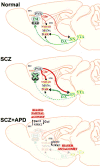New Concepts in Dopamine D2 Receptor Biased Signaling and Implications for Schizophrenia Therapy
- PMID: 27832841
- PMCID: PMC5702557
- DOI: 10.1016/j.biopsych.2016.10.011
New Concepts in Dopamine D2 Receptor Biased Signaling and Implications for Schizophrenia Therapy
Abstract
The dopamine D2 receptor (D2R) is a G protein-coupled receptor that is a common target for antipsychotic drugs. Antagonism of D2R signaling in the striatum is thought to be the primary mode of action of antipsychotic drugs in alleviating psychotic symptoms. However, antipsychotic drugs are not clinically effective at reversing cortical-related symptoms, such as cognitive deficits in schizophrenia. While the exact mechanistic underpinnings of these cognitive deficits are largely unknown, deficits in cortical dopamine function likely play a contributing role. It is now recognized that similar to most G protein-coupled receptors, D2Rs signal not only through canonical G protein pathways but also through noncanonical beta-arrestin2-dependent pathways. We review the current mechanistic bases for this dual signaling mode of D2Rs and how these new concepts might be leveraged for therapeutic gain to target both cortical and striatal dysfunction in dopamine neurotransmission and hence have the potential to correct both positive and cognitive symptoms of schizophrenia.
Keywords: Antipsychotics; Arrestin; Dopamine; Functional selectivity; Schizophrenia; System bias.
Copyright © 2016. Published by Elsevier Inc.
Figures


 ), enhanced activity (
), enhanced activity (
 ) and reduced activity (
) and reduced activity (
 ).
).Similar articles
-
Distinct cortical and striatal actions of a β-arrestin-biased dopamine D2 receptor ligand reveal unique antipsychotic-like properties.Proc Natl Acad Sci U S A. 2016 Dec 13;113(50):E8178-E8186. doi: 10.1073/pnas.1614347113. Epub 2016 Dec 1. Proc Natl Acad Sci U S A. 2016. PMID: 27911814 Free PMC article.
-
Elucidation of G-protein and β-arrestin functional selectivity at the dopamine D2 receptor.Proc Natl Acad Sci U S A. 2015 Jun 2;112(22):7097-102. doi: 10.1073/pnas.1502742112. Epub 2015 May 11. Proc Natl Acad Sci U S A. 2015. PMID: 25964346 Free PMC article.
-
Effects of β-Arrestin-Biased Dopamine D2 Receptor Ligands on Schizophrenia-Like Behavior in Hypoglutamatergic Mice.Neuropsychopharmacology. 2016 Feb;41(3):704-15. doi: 10.1038/npp.2015.196. Epub 2015 Jul 1. Neuropsychopharmacology. 2016. PMID: 26129680 Free PMC article.
-
Dopamine D2 heteroreceptor complexes and their receptor-receptor interactions in ventral striatum: novel targets for antipsychotic drugs.Prog Brain Res. 2014;211:113-39. doi: 10.1016/B978-0-444-63425-2.00005-2. Prog Brain Res. 2014. PMID: 24968778 Review.
-
Mechanism of new antipsychotic medications: occupancy is not just antagonism.Arch Gen Psychiatry. 2003 Oct;60(10):974-7. doi: 10.1001/archpsyc.60.10.974. Arch Gen Psychiatry. 2003. PMID: 14557141 Review.
Cited by
-
PACAP-PAC1 Signaling Regulates Serotonin 2A Receptor Internalization.Front Endocrinol (Lausanne). 2021 Oct 25;12:732456. doi: 10.3389/fendo.2021.732456. eCollection 2021. Front Endocrinol (Lausanne). 2021. PMID: 34759890 Free PMC article.
-
Chronic N-Acetylcysteine Treatment Prevents Amphetamine-Induced Hyperactivity in Heterozygous Disc1 Mutant Mice, a Putative Prodromal Schizophrenia Animal Model.Int J Mol Sci. 2022 Aug 20;23(16):9419. doi: 10.3390/ijms23169419. Int J Mol Sci. 2022. PMID: 36012679 Free PMC article.
-
Towards Novel Potential Molecular Targets for Antidepressant and Antipsychotic Pharmacotherapies.Int J Mol Sci. 2023 May 30;24(11):9482. doi: 10.3390/ijms24119482. Int J Mol Sci. 2023. PMID: 37298431 Free PMC article. Review.
-
α-Synuclein disrupts the anti-inflammatory role of Drd2 via interfering β-arrestin2-TAB1 interaction in astrocytes.J Neuroinflammation. 2018 Sep 10;15(1):258. doi: 10.1186/s12974-018-1302-6. J Neuroinflammation. 2018. PMID: 30200997 Free PMC article.
-
Dopamine D2 receptor modulates Wnt expression and control of cell proliferation.Sci Rep. 2019 Nov 14;9(1):16861. doi: 10.1038/s41598-019-52528-4. Sci Rep. 2019. PMID: 31727925 Free PMC article.
References
-
- Kebabian JW, Calne DB. Multiple receptors for dopamine. Nature. 1979;277:93–96. - PubMed
-
- Missale C, Nash SR, Robinson SW, Jaber M, Caron MG. Dopamine receptors: from structure to function. Physiological reviews. 1998;78:189–225. - PubMed
-
- Benovic JL, Strasser RH, Caron MG, Lefkowitz RJ. Beta-adrenergic receptor kinase: identification of a novel protein kinase that phosphorylates the agonist-occupied form of the receptor. Proceedings of the National Academy of Sciences of the United States of America. 1986;83:2797–2801. - PMC - PubMed
-
- Lohse MJ, Benovic JL, Codina J, Caron MG, Lefkowitz RJ. beta-Arrestin: a protein that regulates beta-adrenergic receptor function. Science (New York, NY. 1990;248:1547–1550. - PubMed
-
- Ferguson SS, Downey WE, 3rd, Colapietro AM, Barak LS, Menard L, Caron MG. Role of beta-arrestin in mediating agonist-promoted G protein-coupled receptor internalization. Science (New York, NY. 1996;271:363–366. - PubMed
Publication types
MeSH terms
Substances
Grants and funding
LinkOut - more resources
Full Text Sources
Other Literature Sources
Medical
Molecular Biology Databases

